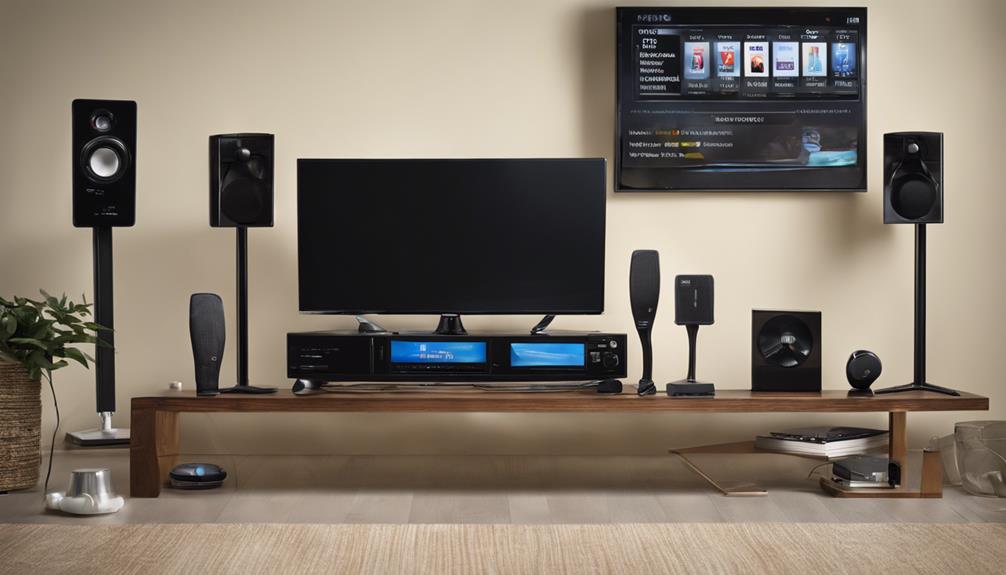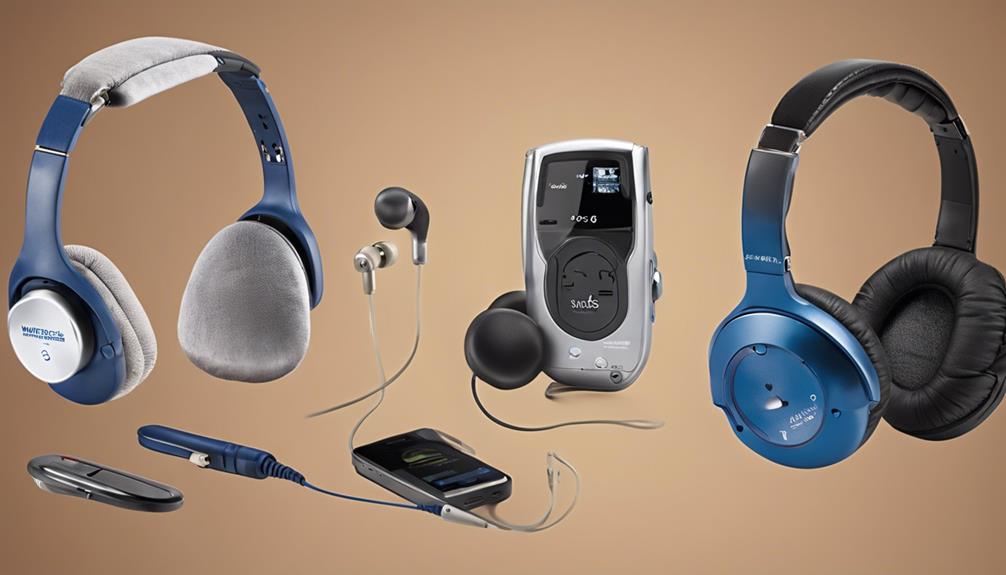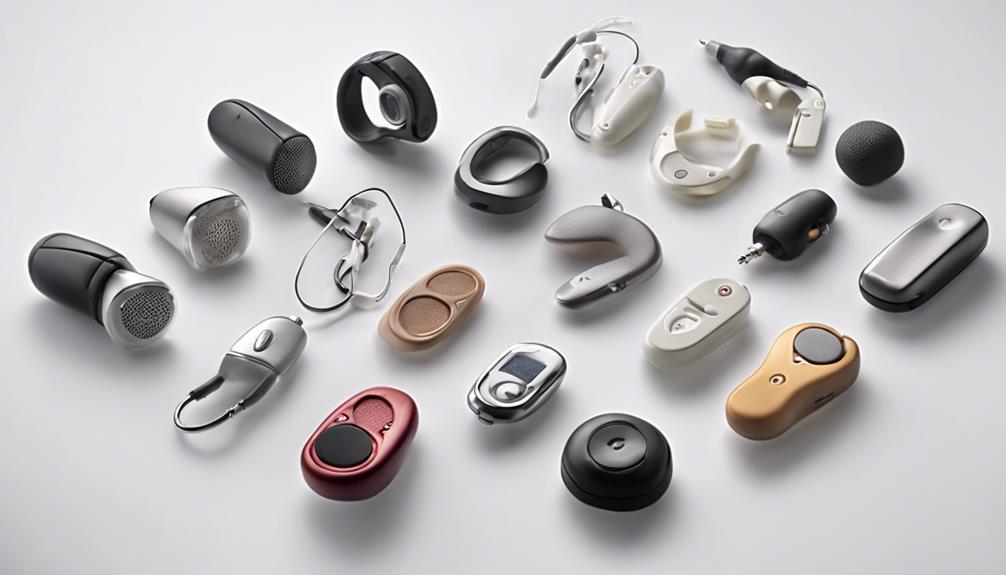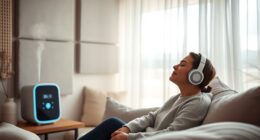Enhancing your TV viewing experience greatly depends on having the right assistive listening device. Imagine being able to hear every whisper, sound effect, and line of dialogue with crystal clear clarity.
But how do you choose the best device to suit your needs? Let's explore some of the top options available that can elevate your enjoyment of television content to new heights.
Key Takeaways
- Assistive listening devices improve TV viewing for individuals with hearing impairments.
- Closed captioning enhances inclusivity by displaying dialogue and audio cues.
- Mandated closed captioning on TVs over 13 inches ensures accessibility.
- Customizable options like toggle functionality cater to individual preferences for an enriched TV experience.
Wireless Headphones
When considering options for enhancing TV audio, wireless headphones stand out for their convenience and advanced technology. These TV headphones utilize wireless connectivity through Bluetooth technology, allowing users the freedom of movement without being restricted by cables. This feature is particularly beneficial for individuals with hearing difficulties who may need to adjust their position for optimal sound reception. Additionally, wireless headphones often come equipped with built-in volume controls, enabling personalized sound levels tailored to the user's preference.
Moreover, some models of wireless headphones are integrated with noise-canceling technology, effectively minimizing background noise and ensuring a clear audio experience. This is especially advantageous in busy or noisy environments where distractions can hinder the TV viewing experience. Furthermore, these headphones are designed to be compatible with a wide range of TV models, making them a versatile option for users seeking an immersive and accessible audio solution.
Hearing Aids With Bluetooth

Considering the advanced technology and convenience of wireless headphones for TV audio enhancement, it's worth exploring the seamless wireless connectivity offered by hearing aids with Bluetooth technology. Bluetooth-enabled hearing aids from top brands like Jabra, Phonak, and Oticon provide an excellent solution for enhancing TV audio. Here are some key features of hearing aids with Bluetooth:
- Personalized Sound Adjustments: Bluetooth hearing aids offer personalized sound adjustments tailored to individual preferences, ensuring an optimal TV viewing experience.
- Direct Streaming: With Bluetooth connectivity, these hearing aids allow direct streaming of TV sound without the need for additional intermediary devices, providing a hassle-free experience.
- Clear Dialogue: Bluetooth-enabled hearing aids ensure clear dialogue transmission, enhancing the overall comprehension and enjoyment of TV shows and movies.
Induction or Hearing Loop Systems
Induction or hearing loop systems are advanced technologies designed to enhance TV sound quality specifically for individuals with hearing aids. These systems utilize electromagnetic fields to transmit sound directly to compatible hearing aids, offering improved clarity and reducing background noise for users.
Ideal for those with telecoil-equipped hearing aids, loop systems create a personalized listening experience by delivering TV audio directly to the user's ears. By bypassing the need for separate headphones or speakers, these systems ensure a more immersive and tailored viewing experience.
Widely utilized in theaters, churches, and public venues, induction loop systems play a crucial role in assisting individuals with hearing impairments to better engage with TV programs by providing a direct and clear audio feed to their hearing aids. Their compatibility with telecoil technology makes them a practical solution for enhancing the TV-watching experience for those with hearing aids, offering a more inclusive and enjoyable entertainment experience.
Infrared Systems and Personal Amplifiers
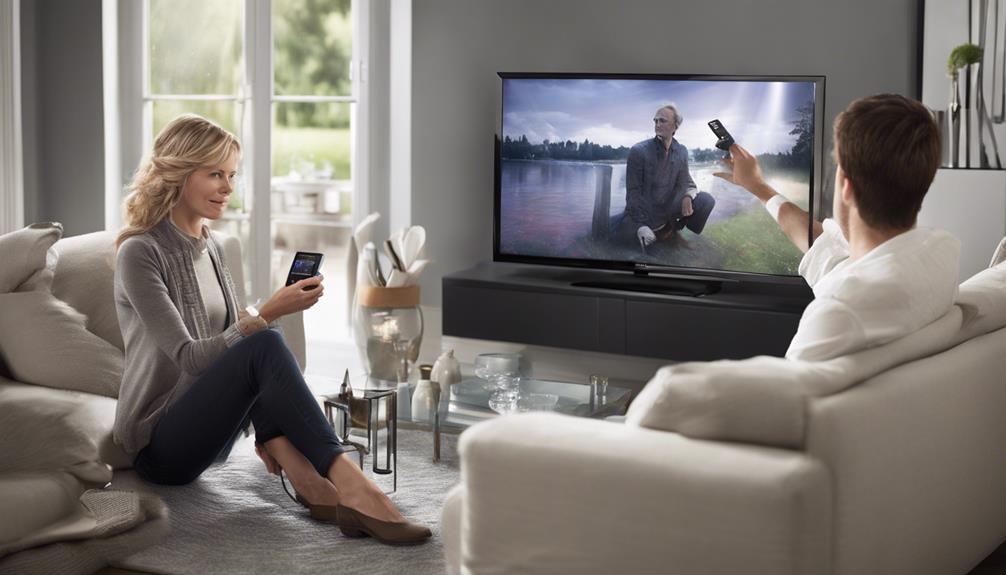
Infrared systems and personal amplifiers serve as innovative audio solutions for individuals with hearing impairments, utilizing light technology to transmit TV audio directly to compatible headphones or receivers while offering customizable sound settings for enhanced clarity and personal preferences. When considering assistive listening devices for TV, these options stand out for their ability to cater to specific needs:
- Light Transmission: Infrared systems use light to carry audio signals, ensuring a secure and interference-free connection between the TV and the headphones or receivers.
- Sound Amplification: Personal amplifiers boost the volume of the TV audio, allowing individuals with hearing difficulties to enjoy their favorite programs without disturbing others in the room.
- Individual Preferences: Both infrared systems and personal amplifiers provide users with the flexibility to adjust sound settings according to their unique hearing requirements, offering a personalized audio experience that enhances overall clarity and enjoyment.
Soundbars With Built-In Amplifiers
Soundbars with built-in amplifiers are a popular choice for enhancing TV audio due to their ability to deliver superior sound quality and clarity. These devices offer a sleek and compact design, making them a convenient solution for optimizing dialogue and background sound balance.
With easy installation and advanced technology, soundbars with built-in amplifiers provide rich, immersive sound to elevate the TV viewing experience.
Amplified Soundbar Benefits
When considering enhanced TV audio clarity, the amplified soundbar with its built-in amplifier stands out as a sleek and space-saving solution. Amplified soundbars offer immersive sound quality, eliminating the need for additional devices while providing a rich audio experience. These soundbars deliver dynamic sound, enhancing the overall TV viewing experience by filling the room with crisp and clear audio.
Additionally, their built-in amplifiers ensure convenient installation and usage, making them an easy and practical choice for those seeking to elevate their sound experience without cluttering their living space. In summary, amplified soundbars combine advanced audio technology with a minimalist design, offering users a seamless and enjoyable way to enjoy enhanced TV sound.
- Immersive sound quality without additional devices
- Rich audio experience and dynamic sound
- Space-saving solution with convenient installation
Enhanced TV Audio
Enhanced TV audio quality is achieved through the utilization of soundbars equipped with built-in amplifiers, which enhance sound clarity and volume for an immersive viewing experience. Soundbars with built-in amplifiers offer a streamlined solution for boosting sound clarity and volume, ensuring dialogue clarity and a personalized listening experience. These devices are easy to install and cater to a wide range of TV models, providing immersive sound without the need for additional speakers or complex setups. The built-in amplifiers in soundbars deliver enhanced audio quality, creating an engaging viewing experience for individuals seeking to improve their TV audio. Below is a table highlighting the key advantages of soundbars with built-in amplifiers:
| Key Advantages | |
|---|---|
| Boost Sound Clarity | Easy Installation |
| Enhance Volume | Streamlined Solution |
| Improve Dialogue Clarity | Personalized Listening |
Closed Captioning
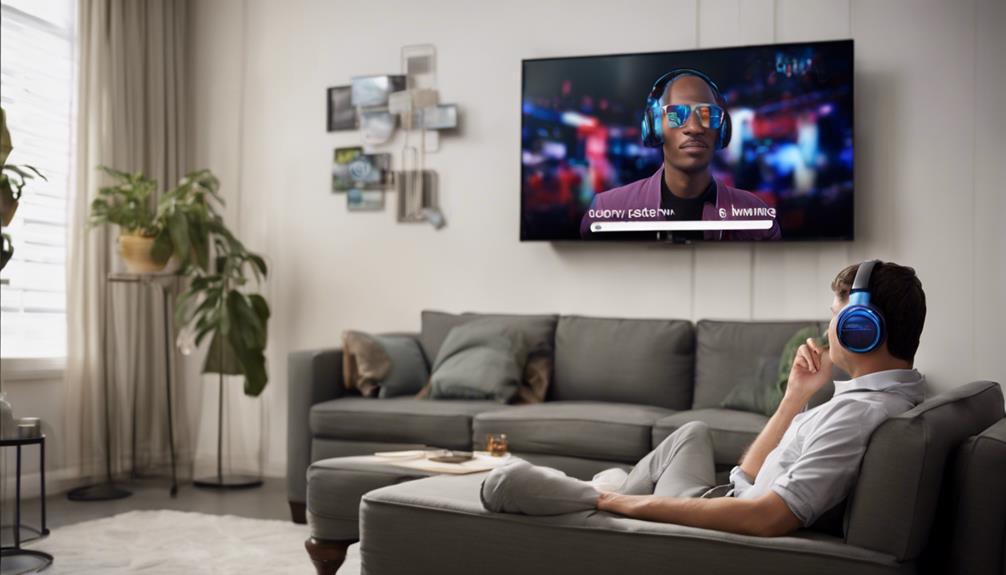
Closed captioning is a vital feature that provides clear text display for dialogue and audio cues during TV programs. It ensures accessibility for individuals with hearing impairments by presenting spoken content as written text.
Viewers can customize their experience by toggling closed captioning on and off, offering a flexible and inclusive viewing option.
Clear Text Display
Utilizing a visual aid like closed captioning enhances the television viewing experience by providing text display of dialogue, sound effects, and background noises for individuals with hearing impairments.
Closed captioning:
- Is mandated by the FCC for TVs over 13 inches, offering text display of dialogue for viewers with hearing impairments.
- Enhances TV viewing by allowing individuals to read spoken dialogue, sound effects, and background noises.
- Provides flexibility as users can toggle captions on and off using a remote control button.
Closed captions improve accessibility for people with hearing loss, ensuring they don't miss any vital information during TV shows or movies. This visual aid complements audio content, making TV programs more inclusive and enjoyable for a broader audience.
Accessibility for All
To ensure comprehensive accessibility and an enriched viewing experience, closed captioning is mandated by the FCC for digital TVs larger than 13 inches to cater to individuals with hearing impairments. Closed captioning allows viewers to read dialogue and audio cues on the screen, enhancing the TV watching experience for those who rely on subtitles. This feature can be toggled on and off with a remote control button, offering flexibility for users. By providing a visual aid that complements audio content, closed captioning makes TV shows, movies, and other programs more inclusive for all viewers. Below is a table highlighting the importance of closed captioning in enhancing accessibility for individuals with hearing impairments.
| Feature | Description | Benefit |
|---|---|---|
| Closed Captioning | Displays text of dialogue and audio cues on screen | Enhances TV watching for individuals with hearing impairments |
| Toggle Functionality | Can be turned on or off using a remote control button | Provides flexibility for users |
| Visual Aid | Complements audio content, making TV shows and movies more inclusive for all viewers | Ensures accessibility for individuals with hearing loss |
Customizable Viewing Options
Enhancing the viewing experience through tailored display preferences is a pivotal aspect of modern television accessibility. When it comes to customizable viewing options like Closed Captioning, it plays a crucial role in enhancing TV viewing for individuals with hearing loss. Here are some key points to consider:
- Visual Aid: Closed captioning provides text of dialogue and audio cues on the screen, enabling viewers to follow the content accurately.
- Accessibility Feature: This feature ensures inclusivity by offering a way for those with hearing impairments to enjoy TV content.
- User Convenience: Closed captioning can be easily toggled on and off using a remote control button, allowing for seamless customization based on individual preferences.
Frequently Asked Questions
What Is the Best TV Listening Device?
When determining the best TV listening device, we consider individual hearing needs and preferences. Quality sound, comfort, connectivity, and ease of use are key factors in our selection.
Wireless TV headphones, sound amplifiers, loop systems, soundbars, and Bluetooth speakers are popular choices. Research and customer feedback guide our decision.
We evaluate battery life, TV compatibility, and cost to ensure the ideal device for an enhanced TV viewing experience.
How Can I Improve My Hearing While Watching Tv?
To improve our hearing while watching TV, we adjust the volume for comfort and consider using wireless headphones or speakers for enhanced sound. Implementing closed captioning and consulting with an audiologist can also be beneficial.
What Is the Assistive Technology for Watching Tv?
When watching TV, we can benefit from various assistive technologies like wireless headphones, Bluetooth-enabled hearing aids, induction systems, personal amplifiers, and soundbars. These devices elevate the audio experience for individuals with hearing impairments, leveraging technologies such as Bluetooth and telecoils to deliver personalized sound output.
Offering customizable settings for optimal sound quality and speech clarity, TV amplifiers and accessories like soundbars and speakers are easily installable and wirelessly connectable, enriching the viewing experience.
How Can I Amplify My TV for Hard of Hearing?
To amplify our TV for hard of hearing, we can explore various assistive listening devices.
Wireless TV headphones with volume control enhance audio. Soundbars/speakers with clarity features improve dialogue understanding.
Loop systems transmit TV sound directly to hearing aids for clear reception. Personal sound amplifiers offer customized sound settings.
Closed captioning provides visual dialogue reading. These technologies cater to individual hearing needs, enhancing the TV viewing experience for us.
Conclusion
In conclusion, whether you opt for wireless headphones, Bluetooth hearing aids, induction loop systems, or personal amplifiers, there are various assistive listening devices available to enhance your TV viewing experience. These devices not only improve sound quality and clarity but also provide personalized settings for optimal dialogue comprehension.
With the right device, individuals with hearing loss can fully immerse themselves in their favorite shows and movies, enjoying every detail with ease and comfort.

